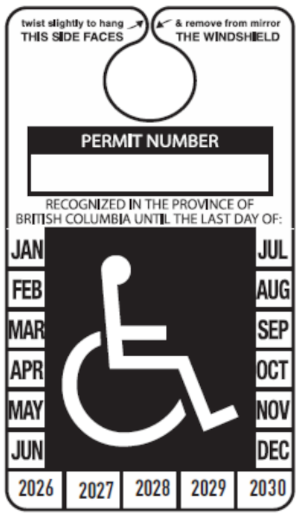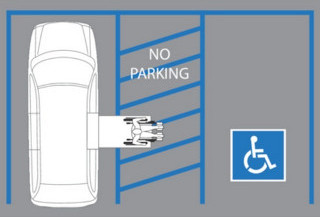 An article on the abuse of handicapped parking stalls by both users and the people who park next to them would be appreciated. I assume that disability parking permits are issued to people who are disabled.
An article on the abuse of handicapped parking stalls by both users and the people who park next to them would be appreciated. I assume that disability parking permits are issued to people who are disabled.
In many cases, the driver is not disabled.
What are the regulations concerning the driver of a vehicle who is not handicapped and the use of the handicapped parking stall?

Who is Eligible for Parking Permits?
Based on a medical doctor's recommendation, anyone with a permanent or temporary mobility impairment is eligible for a permit. People who need extra wide parking spaces in order to get in and out of their vehicle, or who cannot walk more than 100 meters, must use an assistive device or who are legally blind are also eligible for a permit.
If You Don't Have a Doctor
SPARC BC advises that they will accept their application form if it is certified by any professional who has a Physician MSP Number. This would include doctors, physiotherapists and occupational therapists. Doctors practicing at a walk in clinic could certify the form for you.
If you are dealing with an agency other than SPARC BC, you will have to ask them what their certification policy is.
Who Issues Disability Parking Permits?
The parking permit may be issued by a municipality or by an organization designated by a municipality to a person who qualifies as being disabled. In British Columbia, this is most often done by SPARC BC. Other regional agencies around B.C. also issue disability parking permits:
- Cowichan Independent Living
- Nanaimo Disability Resource Center
- People in Motion - City of Kamloops and Thompson/Nicola Region
- Richmond Center for Disability
- SPARC BC - Province Wide
- Special Parking Permit - City of Kelowna
- Victoria Disability Resource Center
These permits are issued to the person, not the vehicle owner or driver. It may be used on any vehicle used for transport of that person, even if they do not drive or own it.
Displaying Your Parking Permit
A disabled persons' parking permit may be displayed by hanging it from the rearview mirror or by laying it on the dash in front of the driver's position when the driver or a person who is a passenger in the vehicle has a disability. This entitles the use of a disabled zone for standing or parking only for the purposes of transporting the disabled person.
Paying for Parking
The safe assumption is that displaying a placard does not exempt you from having to pay for parking. Some municipalities will allow placard holders to park for free in public spaces but you need to check with the municipality or municipal bylaw to know for sure. I am unaware of any exemption from payment in a commercial or private parking lot where a fee is required.
What Happens if Permits are Abused?
Issuing agencies will take action against those who misuse the permit. In order to do so, they suggest that you politely ask to see the person's wallet card, which is issued to all who have a permanent disability. The person is not obligated to show you the card. Should they refuse, contact the agency with your explanation and the parking permit number. They will take appropriate action with regard to the permit.
Not all organizations that issue these permits give the holder a wallet card to go with the placard that hangs from the rearview mirror. In this case the person may not be refusing to show you, they many not be able to.
If You do Not Have a Disability
Vehicles that do not display a valid permit must not stop, stand or park in a handicap parking space. "Just for a minute" is not a justification.
Leaving sufficient space next to a vehicle displaying the permit is important as well. The striped area beside the space indicates room needed to deploy a wheelchair ramp for the person to enter or exit the vehicle.

Towing Offenders Away
The owner of a parking lot may choose to have an improperly parked vehicle towed away. The vehicle owner would be responsible to pay the towing charges involved.
Police action is also a possibility. A traffic ticket may be issued to those who park in a disabled zone when not entitled, to those who use a disabled parking permit when they are not entitled to it and to those who loan the permit to another person, disabled or not.
Use of Disability Parking Permits Issued in Other Countries
A valid permit issued outside of Canada may be used while you visit British Columbia.
Learn More
- Disabled Persons' Parking Permits - Division 38 MVAR
- Police Authority to Remove Parked Vehicle - Section 188 MVA
Share This Article
I’ve also sent it to the people who run the Touching Base thingummies… they’re connected to a fair few disability networks and can probably get the word out a bit further.
- Log in to post comments
Since 2005 I have qualified for a BC handicap parking placard and wallet card issued by SPARC. This blue/white placard and wallet card cost $31.00 and are valid for 3 years.
My experience has been that enforcement of the handicap parking rules has been sporadic on public roads and non-existent in parking lots on private property and open to the public.
Enforcement on public roads is often done by municipal bylaw officers who patrol an area and respond to complaints. Most short-term offenders seem to be rarely ticketed or towed.
Enforcement in parking lots on private property seems to be non-existent because the lot owner and adjacent business owners are not required to provide enforcement and they prefer not have a potential confrontation and alienate customers.
In the Surrey area I have seen, mostly in mall parking lots, many handicap parking spaces with a parked vehicle displaying no handicap parking placard or a placard that is expired or unauthorized.
I have given up on reporting the details (location, date, time and vehicle colour, make/model and plate number) of offending vehicles in handicap parking spaces because it takes too much effort/time and my complaints seem to be ignored.
Handicap parking violations are rampant in the Surrey area because offenders seem to know it is unlikely they will suffer a significant consequence.
The old wallet cards issued by SPARC had the holder’s details (name, ID, DOB, permit number and expiry date) in print that faded within a few months. Last week I received a new wallet card that appears to be much more durable.
- Log in to post comments
I have had a permit for about 25 years now. If my knee is not really bad and there is an available spot close by that is not marked, I will use that and leave the handicap spot available for someone who needs it more than I do.
My wife and I both have placards and often I sit in the car when she goes into a store. I have had a few people give me dirty looks thinking we are misusing them. We normally have mine behind visor and hers behind hers.
I have been prevented from using one by 2 males - guessing in mid-20's who were in the only spot at the bank, were still there when I came out, still there when I came to that area quite some time later. The engine was idling the entire time. When I did ask, there reply was "Well, you found a spot, didn't you?"
Or someone parking so tight to the driver's door I could not open it. Not sure how they managed to squeeze it between my car and the truck parked in the next stall.
- Log in to post comments
That's a great illustration of a parking spot for a disabled person, parking nose-in with a side lift van. They could also have elected to reverse into the other space on their right, if they had thought it out beforehand.
But this isn't representative of most disabled parking spots. Generally, the owner of the parking area will paint some blue space with a white stencil on it that's actually barely adequate; and trying to maneuver a Senior Residence bus (which should only be attempted as a reversing maneuver) into one of these is challenging, particularly if the side operated chairlift is to be employed.
That's probably a key reason why the Handy-Dart buses are all designed for rear loading of wheelchairs (their normal passenger occupancy will be minimal), though some of those drivers need to think much harder about the safety of their procedures, in terms of where they load and unload their passengers.
- Log in to post comments
This doesn't cover how there are those with non-obvious disabilities and the harassment they often encounter over those permits.
It's not up to bystanders to judge whether or not someone using a permit is disabled or not or even disabled enough. I've heard many horror stories from disabled people that face this day after day.
- Log in to post comments
I am constantly harrassed by strangers. I do not have a disabled leg anymore, but the many injuries suffered from a car T boning me where I was a cyclist and the car ran the red light, caused me many injuries. The worst one being the brachial plexus injury to the C5 C6 nerves. I do not look disabled, but I suffer permanent disabilities that are invisible.
Today, 2 old karens came and inspected my windshield then ranted and said they dont even know how I got that pass. I kindly told her I am disabled on the upper extremity and they responded with "I don't see u on a wheelchair. Are you able to drive here? I said I drive with one arm. Then they stormed back to their car and i said im leaving in 5 mins if you want the spot. Then they ignored me so i broke out my ghetto side and yelled at them . I told them I can take off my shirt if u want see the real disabilities. I got so mad I tried to play nice but it is infuriating to be bullied and harrassed.
- Log in to post comments
I have a non visual disability I do use a cane and wear braces on my legs to walk and as long as it’s not to far to walk can park in a regular spot but crossing a parking lot is hard as I am slow and afraid of being hit. People who are complaining about disabled parking spaces should take a good look around at all the regular parking spots and the very few spots for disabled. And maybe they should start putting speed bumps in parking lots so a person has enough time to cross the lots.
- Log in to post comments
- Log in to post comments

I’ve also sent it to the...